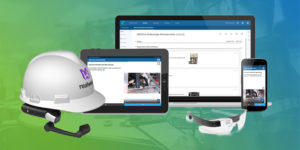Much has been said and written about Digital Transformation in manufacturing, much less has actually been done about it. Gartner defines Digital Transformation as “the process of exploiting digital technologies and supporting capabilities to create a robust new digital business model”. What isn’t said, and often not well understood, is that there are two fundamental […]

Much has been said and written about Digital Transformation in manufacturing, much less has actually been done about it.
Gartner defines Digital Transformation as “the process of exploiting digital technologies and supporting capabilities to create a robust new digital business model”. What isn’t said, and often not well understood, is that there are two fundamental aspects to Digital Transformation:
- The first is that all processes must be connected from end-to-end, with no digital air gaps. In this “Digital Thread” all links in the operations flow are seamlessly handed off from one system to another. In manufacturing this means from order receipt through shipment there is no paper in the process. Similarly in service operations, from ticket inception to closeout, there is no need for paper.
- The second is that all of the processes need to be both instrumented and agile. Instrumented so that you can get the data needed to apply Artificial Intelligence and Machine Learning (AI/ML) analysis to them, and agile so that you can improve them continuously over time.
Limitations of Automation in Manufacturing and Service
In high volume manufacturing scenarios, one of the unheralded benefits of automation has been to close the air gap between systems. Automation creates a machine-to-machine interaction without human intervention all the while generating the data required to feed to AI/ML systems. However, many business processes include activities that still heavily rely on humans to be accomplished and will for quite some time. Whether it is because the activity requires human dexterity, such as some assembly and QA procedures on a factory floor, or complex decision making, such as a field service engineer diagnosing a mechanical problem at a customer site. The costs, complexities, and capabilities of automation often make it infeasible for a large number of manufacturers and OEMs.
This creates a large barrier to Digital Transformation because a key component of digital transformation, the data regarding these operations, is only sparsely available. While high-level data, such as cycle time and yield on the factory floor or after the fact site visit write-ups by a service engineer, often exist, the detailed activities of the human worker are still a veritable “black box”. This is especially challenging for small to mid-sized businesses that overwhelmingly rely on human activities.
So where does that leave these companies — do they have no hope of leveraging AI/ML to continuously improve their business?
Closing the Air Gap of Human Operations
This is where Augmentir™ comes in. Our Connected Worker platform breaks down that barrier to true manufacturing Digital Transformation. Augmentir not only gives companies a way to rapidly author augmented work instructions but, when those instructions are executed by humans, very fine-grained data about the process steps – the tools being used, content being accessed, and results being generated – are captured in a non-intrusive manner and then fed back into the appropriate enterprise systems. Simply put, Augmentir closes the air gap of human operations, enabling humans, and the work they do, to become a fully integrated part of the digital thread.
Augmentir also solves the second, even more challenging aspect of Digital Transformation. It has has been estimated that data scientists spent 80% of their time cleaning and labeling data. Collecting and making sense of the sparse and noisy data streaming back from human activities has been a huge barrier to taking advantage of the advances in AI/ML technology to optimize human-centric operations. The Augmentir platform not only collects the fine-grained data, but cleanses, labels it, and then presents it to our embedded AI engine to develop unique insights into your operations. These insights help organizations identify where opportunities for improvement exist. This is the virtuous cycle of continuous improvement that is the hallmark of a “digitally transformed” organization.
Are you interested in learning how your organization can leverage augmented work procedures to close the air gap of human operations and continuously improve processes? Schedule your personalized demo and see Augmentir in action.

